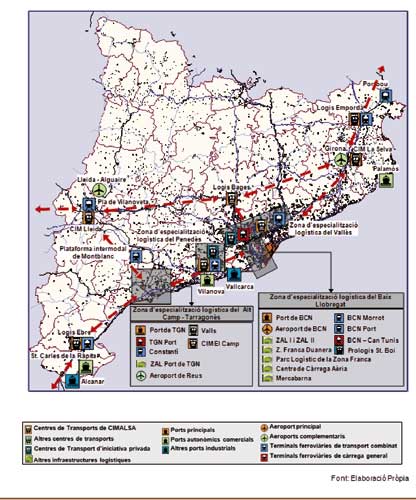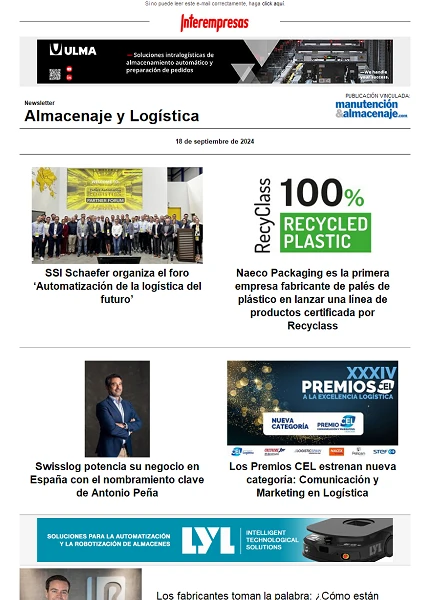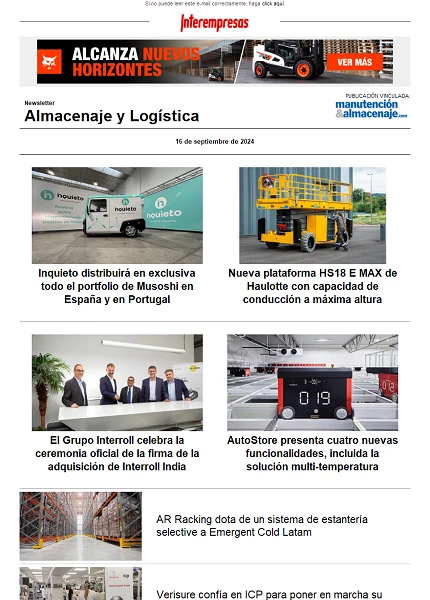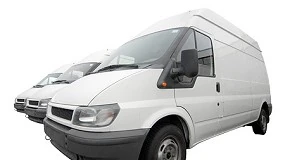The aerial logistics, maritime and rail wins terrain to the road
24 January 2012

But the crisis has caused a change of tendency, with a descent of the tonnes of 26% between 2007 and 2010. In the last period analysed (2009-2010) the tonnes moved have fallen in a -5,5%. However, the analysis of ways, shows how only the volume movilizado by road follows decreciendo.
- Road: - 9,4%
- Rail: + 8,7%
- Maritime: + 3,5%
- Aerial: + 16,3%
The logistical sector. Typology of traffics
The internal traffic follows losing quota put that it is the one who experiences a greater fall in what volumes movilizados.
Volume of commodities
- Year 2007: 541,3 Mt.
- Year 2008: 500,7 Mt.
- Year 2009: 425,6 Mt
- Year 2010: 402,0 Mt
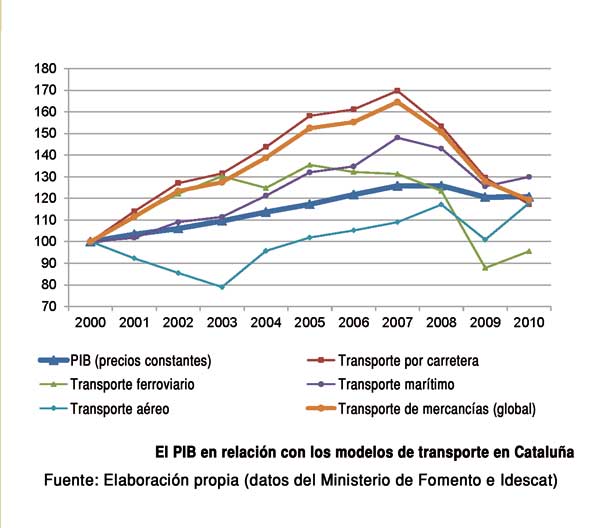
| Type of traffic | 2007 | 2008 | 2009 | 2010 |
| Internal | 57% | 54% | 53% | 49% |
| Maritime/aerial | 16% | 17% | 18% | 19% |
| With the rest of Spain | 15% | 16% | 16% | 17% |
| Of step | 7% | 8% | 8% | 8% |
| International terrestrial | 5% | 5% | 5% | 7% |
The economic weight of the logistics in the economy has happened to represent 2,3% in 2008 to a 2,1 in 2009
The logistical sector: unimodalidad vs. intermodalidad. Quotas
The quotas intermodales have tended to increase during the crisis. This has to , no so much to a catchment of flows of said chains but rather to a greater fall of the volume moved by the chains unimodales of road.
| Quotas | 2007 | 2008 | 2009 | 2010 |
| Unimodales | 82,1 | 80,9 | 80,3 | 78,1 |
| Intermodales | 17,9 | 19,1 | 19,7 | 21,9 |
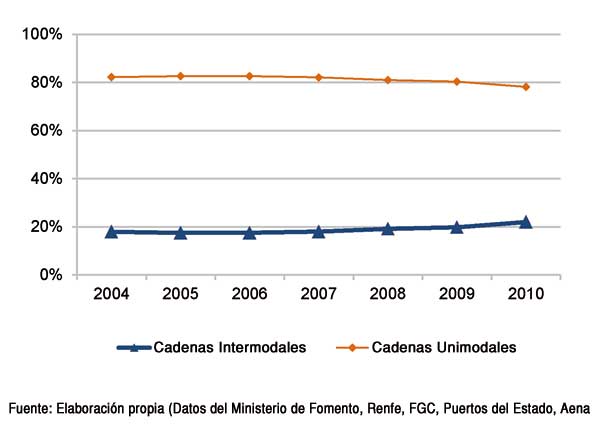
The logistical sector: Generation of occupation
The generation of occupation of the logistical sector has increased with regard to the one of the industrial state. In the last year analysed (2009), the number of employees in the logistical sector experienced a light descent (-3,2%) in front of the occupation of the industrial, that fell in a -16,5%.
The road way
The impact of the economic crisis in the sector of the road transport shows with a fall of the volume movilizado of the -9,4% in the last period analysed (2009-2010). The analysis of the evolution of the tonnes in function of the type of traffic puts of relief that the internal flows are the only that decrecen, with a fall of the -14%. By against, the state traffics stagnate and the international increase in 22%.
The percentage of travel in empty is especially significantly in the internal flows of Catalonia, situating around 47%. This percentage has not showed indications of improvement in the last years.
The average of employees by company finds stagnated in near of 3 employees by company from the start of the series (2003). It is necessary to take into account that in the same period, some European countries tended to increase the business dimension. It is the case of Luxembourg, that happens of 12 to 19 employees by company, Germany (of 8 to 9) or Holland (of 12 to 14).
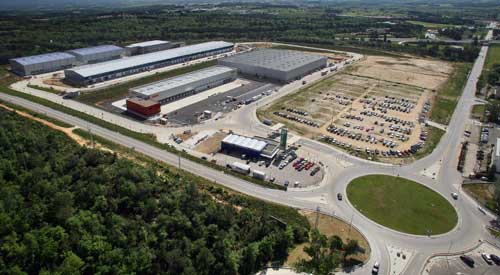
Typology of flows in the road way
In this way, the internal flows have fallen until 14% of the total volume, whereas the international tonnes increased 22%. Besides, the exports by road way also increased 25% whereas the imports remained in 19%.
Regarding the travel in empty, the percentage of these has stagnated in the last years on 44%. This ratio is especially notable in the internal travel (47%) whereas, for traffics with the rest of the State and international, keeps on 20%.
On the other hand, stand out that the companies of transport of commodities by road of Catalonia have some 3 employees by company, roughly. This figure finds in ‘stand-by' in Catalonia and far of the average of the EU-25 (5 employed/company) as of the EU-12 (8 by company). Thus, from the Observatory aims that increase the business dimension is key to improve the competitiveness of the sector of the road transport in the frame of the EU.
The rail way
According to the data of the Observatory, the volume of tonnes moved by railway industry in 2010 has increased 8,7% with regard to 2009. This data, joined to the fall of tonnes in the road way, has supposed an increase of the rail quota until 2,1%.
So much the volume of internal exchanges as with the rest of the State have increased 15%. To this tendency has influenced positively a growth of 40% in the tonnes transported by FGC (standing out the increase of the demand in the section of salts potásicas and to Cargometro) and an increase of 75% in the containers transported by railway industry to the Port of Barcelona.
Has detected also a decrease of the quota of the international transport. In the last year, contrasts the fall of the -3,5% of the international rail tonnes, with an increase of 22% in the international volume of road. On the other hand, it keeps the tendency to the rationalisation of the circulations: the number of regular circulations realised has fallen a -8,1% in the last year, in front of the increase of tonnes experienced.
On the other hand, stand out that the puntualidad of the way decrece slightly, a -0,7%, keeping next to 83%, whereas the delay of the circulations impuntuales of 2010 keeps in 3 hours.

rail Quota and quality of service
In this section, detects a growth of four tenth of the rail quota until 2,1%. The Observatory besides also aims to a tendency in the growth of the quota in the internal and state traffics as well as a descent of the same in the international traffics.
Regarding the quality, observes a rationalisation of the circulations: a descent of the -9,7% in number and an increase of 8,7% in volume of tonnes transported (politics of increase of the length of the trains-containers TLE). On the other hand, it keeps the puntualidad in 83% of arrivals in hour in 2010.
The maritime way
The Ports of Barcelona, Tarragona and the Government of Catalonia experienced in the last year a growth of 3,5% in total tonnes. 2010 it meant a turning point in the declining tendency experienced after the crisis from 2007.
Stand out also the increase of the traffics of long distance with the Next and Half Orient, Asia and America, that evolve with growths of the 11, the 9 and 8% respectively. The flows with Italy – France and the North of Africa experience a tendency to the recovery, with growths of the 6 and 10% in each case, in the period 2009-2010.
The number of TEUS moved in the Ports of Barcelona and Tarragona experienced positive evolutions, with growths of the 15 and 8% respectively. This data supposes an impulse on the tax of contenerización, that increases in both Ports (in 6% in Barcelona and 12% in Tarragona).
On the other hand, between the modal quotas of access to the Ports stands out the rail of the of Barcelona, that has suffered an increase of 76% in the last year, happening of the 2,1 to 3,7% of the tonnes moved.
In fact, in the last year analysed (2010), the half time of physical inspection of the Port of Barcelona has followed the declining tendency initiated in 2006, arriving to the 134,3 minutes.
Traffic by geographic regions
The flows with Italy and France and the North of Africa experienced growths (6 and 10% in the last year) partly thanks to the positive evolution of the services of ‘short was shipping (SSS)'. The traffics of long distance followed a positive tendency, with growths in the Next and Half Orient, Asia and America, of the 11, 9 and 8 % respectively.
Prices of containerización
- Port of Barcelona: Taxa of 44,8% (increment of 6%)
- Port of Tarragona: Taxa of 8,7% (increment of 12%)
modal Quotas of access to the Ports
In the last year stands out especially the increase of 76% of the rail quota to the Port of Barcelona. Thanks to this increase, the modal quota to said port approaches to 4%. It is reseñable also the increase of the volume of TEUS moved in railway industry (75%) and the one of vehicles (that they grow in 101%).
The aerial way
The load in the airport of The Prat has recovered of the descent experienced in the previous period with a growth of 16,3%, increase that finds on line with the evolution of the world-wide load (+15,2%). The volume of tonnes, next to the 105.000, represents the highest register of all the series of data from 2005.
Europe, by his part, follows consolidated like the region with greater quota of exchanges, with a representation closely of 60% (annual growth of 1,5% from 2005).
Fits to stand out besides the growth of the traffics of exchange with Asia and Pacífico, that already represent near of 20% of the exchanges. It is important also resaltar that this destinación represented 1% in 2006.
On the other hand, the quota of commodity transported by aeroplanes of pure load keeps growing and reaches 42% of the total volume. However, the transport of commodities in the cellar of aeroplanes of passengers follows diminishing and situates in 20% of the quota.
aerial Traffic of commodities by regions
The Observatory detects also an increase of 16% in the quota of the traffics with Asia and Pacífico, as well as one some solidez of the exchanges with Europe, with a quota of 60% of the total: between these, stands out Germany (and more specifically the Airport of Colony) with 50% of the total volume.
The aerial way: traffic by type of aeroplane
- Growth of the quota of mercancían transported in loaders pure.
- Maintenance of the quota of the aerial truck.
The logistical floor: conclusions
Catalonia concentrates 23,3% of the total of the useful surface of logistical warehouses in Spain. It stands out the province of Barcelona, that represents 72% of the total of Catalonia.
In the last year, the half price for hire of floor in Catalonia has fallen a -10,8% and observes a tendency to the increase of projects ‘key in hand' to end to ensure the future obtaining of incomes.
The option for hire of floor tends to impose in front of the option of purchase (in 2007 the rent represented the preference in 50% of the cases. In 2010 this value was upper to 90%).
On the other hand, of 2005 to 2010 the surface in Catalonia has increased annually in 4,3%, standing out the case of Tarragona that, in the last year, that increased in 21,5% the useful space (value promoted by the put in service of the CIM The Camp).
Regarding the price of the floor, in the analysis elaborated by Cimalsa detects a descent of the prices in Catalonia of the -10,8% in the last years. Barcelona and Tarragona head this list, with a descent of the -10% whereas Lleida and Gironinginga presented descents more slight, of the -5,2 and -4% respectively.
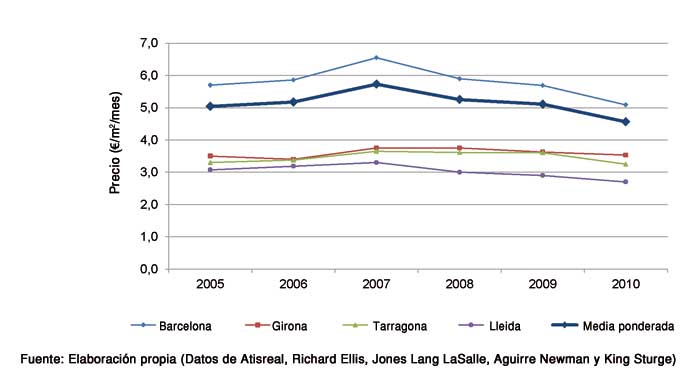
Recopilar and share information
The Observatory of the logistical wants to be a tool of continuous evaluation of the needs of the economic sectors in relation with the system of infrastructure and logistical services.
A meeting point between the companies and the agents decisorios that allows to integrate the needs of the business fabric with the planning and management of infrastructures and services. The aims of the indicators of Competitiveness of the Logistical System are:
- Create a frame of stable reference along time based in real parameters and of objectivity in the observation
- Monitor the most notable data of the logistical system and analyse his evolution by means of the contrast with experts in each matter
- Turn into a tool that contribute information for the planning and management of the Logistical System
